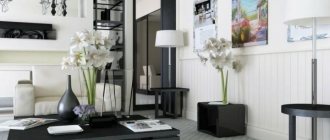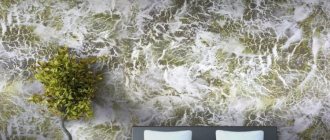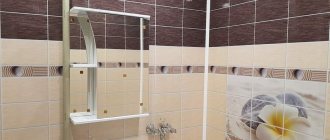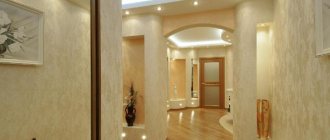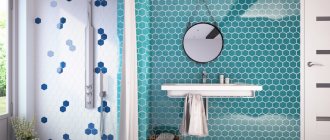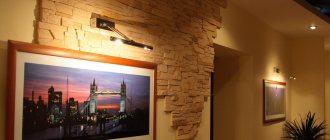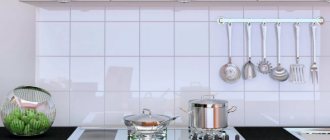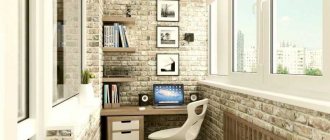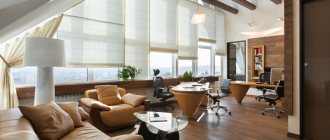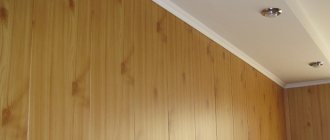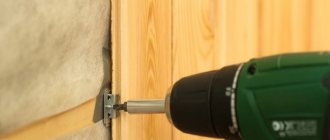When building a private house, a planned project is often chosen, which is not original. But interior wall treatment will help make your home individual. To create a unique cozy atmosphere, banal wallpaper will not be enough. It is better to pay attention to decorative panels for walls. This material, from the moment of its appearance, quickly gained popularity and demand.
3D wall panels for interior decoration Source lost-empire.ru
Pros and cons of plastic panels
This material has a large number of positive qualities. These include:
- easy installation. Installing such material will not be difficult. Finishing wall panels requires special care. First of all, you need to prepare a frame on which each plastic element will be attached;
- heat and sound insulation. There is a small distance between the wall and the panels, which absorbs loud sound. In addition, an “air cushion” of warm air appears here. It, in turn, prevents cold air masses from entering the room.
- a light weight. This design looks neat on the wall surface;
- durability. The materials and components that make up the panels are particularly durable;
- affordable price. Artificial wall panels have a low price range. Natural materials have a beautiful appearance and have a higher price. As a rule, they have high strength.
Modern panels can imitate natural solid wood, brick and other types of surface.
Materials
For production, both natural materials or materials made from natural components are used, as well as chemical industry products. The first include: solid wood, fiberboard, chipboard, MDF, plasterboard, gypsum vinyl, glass. For the production of the latter, PVC is used. Often, manufacturers use two or three types of materials at once, combining organics with artificial substances.
PVC
Panels made from this material make up the majority of those sold on the market. Available in all three types. The popularity of this material is due to its versatility, i.e. Possibility of use in premises for various purposes and in any climatic conditions. Polyvinyl chloride is easily processed, taking any shape; various designs, patterns, and photos can be applied directly to it. You can easily reproduce an imitation of brick, tile, board, stone or marble slab. The main disadvantages of PVC boards are fragility, flammability, and toxicity when heated strongly.
MDF
The composition is similar to fiberboard, but has a lower density. For this reason, MDF is sometimes called “soft” fiberboard. But due to this “softness”, the slabs have increased heat and sound insulation properties. During the production process they are given other properties. For example, using PVC as cladding, you can achieve good moisture resistance of the slabs. Special compounds that the manufacturer often impregnates the panels with make them fireproof. Such technological maneuvers cannot but affect the increase in cost, but this is a completely justified trend.
Gypsum vinyl
These can be called drywall upgrades. The cardboard face layer was replaced here with a vinyl layer. Walls, partitions, and ceilings can be made from this material. Drywall is noticeably inferior to gypsum vinyl in strength, durability, and presentation. The latter does not require painting, since it already has a ready-made pattern or other color. Initially, this product was intended for public buildings with a large flow of people, but over time they began to be used for private housing.
Fiberboard
A common material in the wall panel industry. In production, wood fibers are used, which are joined together by hot pressing. The advantages of such boards are low cost, environmental friendliness, and the possibility of lamination with veneer or plastic. Sometimes you can find fiberboard upholstered with natural wood slats. They produce all three types of execution. The slabs are attached directly to the wall or to a pre-installed sheathing. They are connected to each other using the locking method or the tongue-and-groove method.
It is not recommended to decorate rooms with high humidity with fiberboard slabs, since they are greatly deformed due to dampness and move away from the walls.
Chipboard
Produced from wood waste. Therefore, in many respects they are inferior to natural solid wood. But all the shortcomings are more than covered by the low price. To give chipboard sheets a presentable appearance, they are coated with plastic. The color range of plastic coating can be very diverse. During the manufacturing process, wood chips are mixed with an adhesive composition and pressed. The glue used is toxic and harmful to humans. But the presence of a plastic coating neutralizes this factor. Like fiberboard, chipboards cannot withstand high humidity and swell greatly. The large specific gravity (higher than that of common wood species) imposes restrictions on the form of chipboard production. They are produced only in sheets.
Made of wood
Rooms decorated with natural wood create a feeling of warmth and comfort. And these feelings appear in you for a reason. People have long been aware of the thermal insulating properties of wood. And the essential oils contained in the fibers have a beneficial effect on the lungs, having a calming effect. The more expensive the array, the more pronounced the above-mentioned properties are. The most popular raw materials for the production of wood wall panels are species such as oak, alder, walnut, maple, linden, cedar, and bamboo. Lovers of classic Western style will love the panels finished with natural veneer. And for admirers of oriental notes in the interior of their home, bamboo mat panels are more suitable. They are woven by hand from strips of bamboo and impregnated with a special adhesive to give them a marketable appearance and extend their service life.
For those who decide to decorate a bathroom or sauna with wooden panels, products are available for sale that are coated with a special water-repellent varnish or wax, which, when heated, does not emit substances harmful to humans.
Varieties of design
Construction stores offer a huge selection of finishing materials. Each type is distinguished by its own modification, method of fastening and structural components. On sale are:
Rack elements. They are long slats whose size ranges from 250 cm to 350 cm. The thickness of each part varies from 9 to 15 mm. This material is suitable for decorating a small room or its corner parts.
Installation of slatted wall panels is carried out by attaching parts to a metal frame using short self-tapping screws.
Tiled structures. They are large squares. The dimensions of the panels range from 40 to 80 cm. Installation of such elements is carried out using special glue. You can also use additional fasteners that secure the elements together.
Such structures are made from MDF, fiberboard and chipboard. These materials have a low cost, which makes them accessible to absolutely everyone.
Sheet panels. Among all the models they have the largest parameters. The length of the finished product is about 1.5 * 2.5 m. The thickness of the canvas varies between 5 -7 mm. They consist of fiberboard or MDF. On the surface of the panel there is a textured base that imitates natural wood, tile or brick.
Textile or leather panels in a modern interior
Soft panels are most often used to decorate bedrooms, children's rooms, and sometimes to create an accent wall in the living room. Excellent sound insulation, environmental friendliness and original appearance are what captivate our compatriots to use textiles or leather to decorate all or accent walls in their homes.
If you decide to purchase wall panels coated with leather, then pay attention to artificial analogues - they are much cheaper than natural material, and outwardly have similar aesthetic properties. Soft faux leather panels are easy to care for and incredibly practical - they withstand moisture, do not fade in the sun, and can be cleaned with a damp sponge and wiped dry to achieve perfect cleanliness.
How to choose the right wall panels?
At first glance, choosing wall decor will not be difficult. In addition to a beautiful appearance, it is important to consider the following parameters:
- flammability;
- flammability;
- toxicity. This point indicates the synthetic composition of the panels.
- smoke formation The lower the values, the better the materials from which this structure is made.
There should be no chips or cracks on the surface of the wall panels. All these damages shorten the service life of the product. If the parts consist of multilayer materials, then there should not be any bulges or dents.
The color palette of each element should be the same. If there are minor deviations, it is recommended not to purchase this product. This indicates improper storage of the material or a violation of the manufacturing process.
Locks on the edges of wall panels are a major requirement. They can be made of lightweight metals or durable plastic.
As you can see, decorating your living space will not be difficult. Good imagination and high-quality materials help create a real masterpiece. The photo of wall panels shows the best options for models that will decorate any interior space.
Curtains for the kitchen - 120 real photos of new designs. Options for the ideal combination of modern curtains in the kitchen interiorHow to diversify your home interior: DIY decor and beautiful design ideas
- How to hang curtains - step-by-step instructions with photo examples and recommendations. Exclusive curtain design solutions from experienced craftswomen
Where to use in decoration
Wall panels in the interior can perform a variety of tasks: from a decorative function to hiding wiring, various wall defects, insulation, and soundproofing a room. If everything is simple with the practical side of things, then with the decor everything is much more complicated. There are several methods for distributing panels on the wall plane that will help achieve maximum aesthetic effect:
- Only part of the wall. The traditional technique is when the panels are attached to the bottom of the wall. At the same time, try to maintain a proportion of 1:3, i.e. they should be located no higher than the lower third of the wall. This will create the effect of high ceilings. Well suited for the living room, corridor, hallway, nursery, kitchen, bathroom;
- All over the wall. This option is a classic and emphasizes the status of the room. It is better to avoid using it for very small rooms with low ceilings, since the design will make the room feel heavier. You should not resort to this technique in the rooms where you spend most of your time. Wooden panels would be most appropriate here. Suitable for library, billiard room.
- Emphasis on decor. With this option, you select a specific section of the wall or several intervals to decorate with panels. In this case, you do not need to tie the height of furniture and decorative items to a certain value, as in the very first technique. Here you will not burden the space in any way if you arrange all the interior items correctly. It will look good in the bedroom, living room, hallway.
And don’t forget - the final choice is always yours!
Tree
An excellent solution for those who value the environmental friendliness of the material, but it is worth remembering that wood requires special care so that the panels serve you as long as possible.
This type of coating will look quite organic in country or Provence style interiors. The panels will also look stylish in more modern styles - it all depends on the decor you choose.
Metal
This coating in the interior looks very impressive and unusual. Despite the appearance of a natural metal sheet, it is usually a special film that is applied to some kind of base, such as wood or plastic.
Due to this, the material retains ease of installation, but does not lose its effectiveness.
Bamboo
Suitable for you if you like ethnic style, for example, Chinese or African. Expensive and rarely found in interiors.
They will perfectly convey the atmosphere of the East in your home if you are a connoisseur of such decor.
Mirror
Such panels will help visually expand the room and make it larger. This will also help increase the amount of light in the room.
Due to the fact that the panels are made using different technologies, they can be made on the basis of acrylic, which gives it flexibility, allowing you to decorate even rooms of complex shapes and formats.
Polyurethane
Despite the obvious non-ecological friendliness of the material, they are distinguished by useful practical properties, for example, resistance to damage. The panels are very light, which makes installation easy. In the interior they are used not only for walls, but also for ceiling decoration.
Such panels are suitable for you if you have a non-standard room, because this material easily takes different shapes, unlike the same plaster.
Polyurethane has poor thermal conductivity, which can be considered both a plus and a minus, depending on the climate in which you live. This feature will work to your advantage if you live in a cold region - this material will allow you to keep warm in the apartment.
PVC
They will help you make a coating to look like natural stone or wood at a low and affordable cost.
PVC panels are very diverse in shades and textures, which will help you realize all your design fantasies at a low price.
Stone veneer
This material is perfect for you if finances or room features do not allow you to use natural stone, because the distinctive features of stone veneer are light weight, low cost and flexibility.
In addition, the veneer completely replicates not only the appearance of the stone, but also its texture.
Such panels are installed using specialized glue.
Glass
There is no need to be afraid of the fragility of this material, because modern technologies make it possible to produce panels of special strength.
Glass coating has only recently begun to be used for decoration, so it looks unusual and new, especially in minimalist and high-tech interiors.
In addition, glass panels are resistant to moisture or high temperatures, which is ideal for decorating the kitchen area, bathroom and more.
In the kitchen you can use a glass panel with a pattern; some designers use it as an apron.
Application area
Such user-friendly characteristics allow them to be used for finishing almost any room:
- hallways
- living rooms
- bedrooms
- bathroom
- toilet
- kitchens
- balconies and loggias (including unheated)
Often these materials are used for finishing commercial premises (offices, warehouses, etc.).
Chipboard
They are made from wood chips and are very cheap. Like many types of panels, sound insulation can be added.
One of the most significant disadvantages is the harmful and not environmentally friendly composition, as well as susceptibility to deterioration from steam, moisture or mechanical stress. In addition, such panels are quite heavy, so installing them will not be easy.

